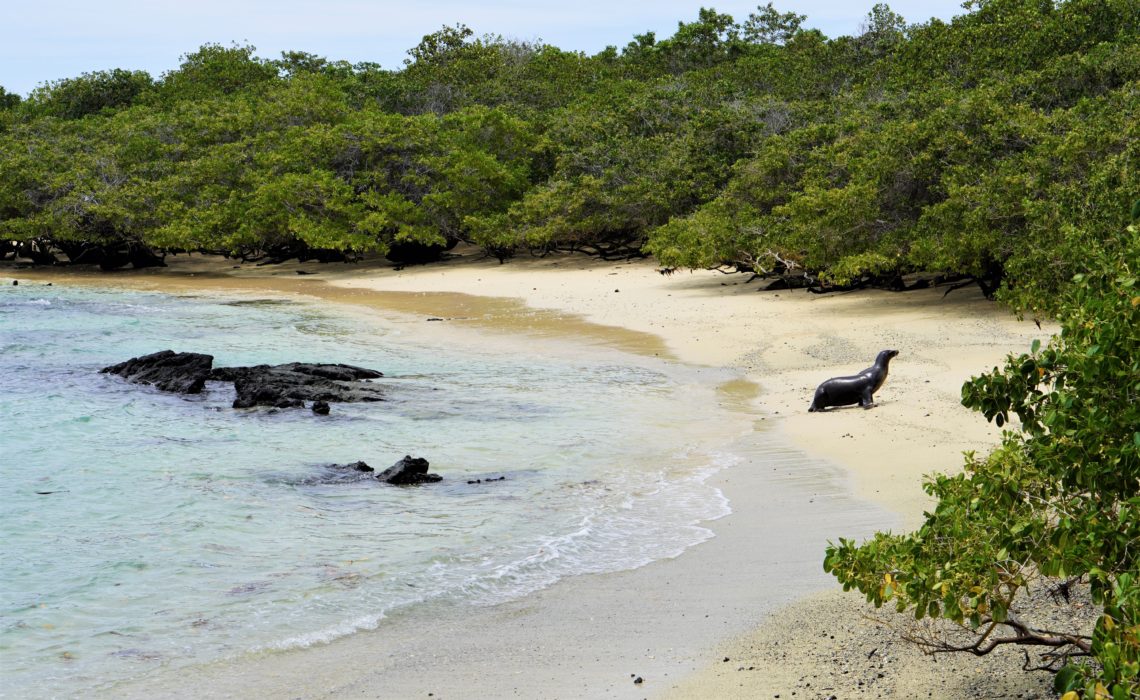
The best part about visiting the Galapagos islands is when your friend invites you to crash her honeymoon; not just me, obviously! It was a group of about 12 of us, all friends of the bride and groom who shared this experience together.
Located about 600 miles off the coast of Ecuador, the Galapagos Islands are a true paradise for nature lovers and adventure seekers. The islands are home to a wide variety of unique and endangered species, such as giant tortoises, marine iguanas and blue-footed boobies, and offer a variety of activities, such as snorkeling and hiking.
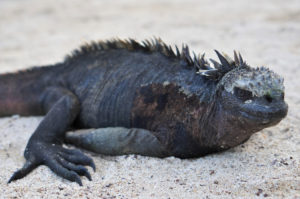
We flew from Quito to Baltra Island. Our flight was about 3h long, but with the time difference you get an hour back. Our friends had booked through a local agency that gave us a quote of about CA$1500 per person for the flight, food and accommodation for 5 days, and entry to the main attractions. This didn’t include the US $20 to obtain the Transit Card from the offices of the Government Council of the Special Regime of Galapagos located at the departure airport in Quito; nor did it include the National Park entrance fee which, depending on your nationality, can be US$50 or US$100, that you pay as soon as you land. After our luggage was inspected at the airport to ensure that we did not bring any of the prohibited items, including plants or animals, we were transferred by bus and by boat to Santa Cruz Island, which name in Spanish means “Holy Cross.”
Santa Cruz
Santa Cruz is the second largest of the Galapagos Islands and is located in the center of the archipelago. Half of us stayed downtown in a much better hotel where a sea lion had appropriated the swimming pool. The rest of us were dropped to the hotel “in the highlands”, as it was described by our tour guide. Despite not living up to our expectations, Tortuga Bay, the hotel we stayed at, provided an environment that allowed us to form strong connections and create meaningful experiences. The hotel was situated in a secluded area surrounded by dense vegetation. Once we turned off the main road, we discovered that we had lost mobile signal, despite having purchased Ecuadorian SIM cards. The hotel did not have Wi-Fi either, in spite of the signal at the reception desk indicating otherwise.

After taking a quick break at the hotel, we had to deal with the unreliable internet connection and mobile service issues to arrange for cabs to take us downtown, where we reunited with the rest of the group to visit the Charles Darwin Research Station. As we walked around, we were amazed to see entire families of iguanas nonchalantly going about their business on the pavement.

Charles Darwin Research Station
A ten minute walk from the center of Puerto Ayora, the Charles Darwin Research Station is the operational center of the international non-profit Charles Darwin Foundation. It was established in 1959 with the purpose of conducting research on the unique flora and fauna of the Galapagos, as well as to promote conservation efforts to preserve the islands’ delicate ecosystem.

Our guide took us through the different iguana types, and taught us how to distinguish the age and gender of tortoises, as well as shared details of their reproduction process. The most interesting fact that we learned was that the turtle eggs that were deeper in the ground were more like to be male due to something called temperature-dependent sex determination. Research has shown that if a turtle’s eggs incubate below 27.7° Celsius, the turtle hatchlings will be male, while if the eggs incubate above 31° Celsius, the hatchlings will be female.
Turtle Bay Beach
The following day, we embarked on a 45-minute walk through a trail with thick foliage that led us to Turtle Bay Beach (Tortuga Bay). The trail was full of finches and mockingbirds along the way, and we even spotted lava lizards scuttling across our path. The Turtle Bay Beach is evidently considered one of the most beautiful beaches in the archipelago. With its pristine and blue waters and powdery white sand, it was hard to discern the boundary between the sea and the sky.
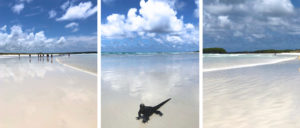
The beach was teeming with black-colored marine iguanas, ambling along the sandy shores and basking in the sun. They seemed entirely at ease in their surroundings, unaffected by the curious gazes of the many onlookers who were trying to capture the perfect snapshot. These fascinating creatures appeared entirely unbothered by the presence of the humans around them, confidently going about their day-to-day business as if they owned the beach. Despite the main beach area at Turtle Bay being breathtaking, it is not ideal for swimming due to its big waves. Therefore, we opted to sunbathe in the area behind the main beach where the water was calm and resembled a large pool.
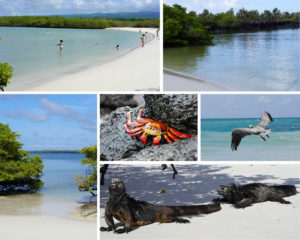
Giant Tortoise Reserve
In the afternoon, we ventured to the Giant Tortoise Reserve, Rancho Primicias, situated just half an hour away from Puerto Ayora. The ranch provided us with boots that allowed us to effortlessly explore the area and stroll through ponds, creating an even deeper connection with the stunning surroundings. The ranch is famous for its giant tortoises, which roam freely in their natural habitat. We were able to get up close and personal with these gentle giants, learning about their history, habits, and conservation efforts.
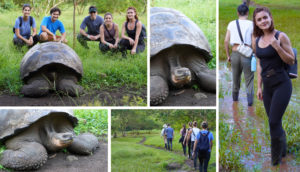
The centenarian turtles we saw at the reserve stood as a timeless marvel, with shells weathered and worn by a century of living. Their eyes, wise and knowing, seemed to hold secrets of ages past, while their slow and steady movements spoke of a lifetime of experience. Their wrinkled skin bore witness to the passage of time, as it carried the weight of history on their back. And yet, despite their age, the turtles exude a quiet strength and resilience, a testament to the enduring power of life.

Lava Tunnels
We also stopped at another unique natural wonder, the Lava Tunnels (Tuneles de lava), which is a network of lava tubes formed by molten lava flowing through underground channels that were created during volcanic eruptions thousands of years ago. As the lava flowed, the outer layer of the lava cooled and hardened, forming a crust that eventually created a tunnel-like structure. Over time, the tunnels became hollow as the lava continued to flow through the center, leaving behind a network of underground passages. It is said that the tunnels were used as a shelter during pirate attacks in the 17th and 18th centuries.
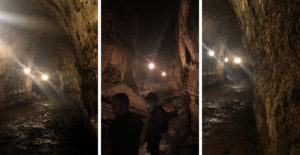
After a brief break at our hotel, we ventured out to discover Santa Cruz by night. Eventually, we found ourselves at Bongo Bar, indulging in refreshing piña coladas and margaritas while exchanging our thoughts and experiences from the day.

Las Grietas
The following day, we ventured to Punta Estrada to catch a glimpse of the diverse wildlife, including terns, boobies, frigate birds, and sea lions. We crossed the Canal del Amor, where we were encouraged to make a romantic wish, before making a stop at Shark Channel to observe the unique cactuses and take in the stunning views of the port and highlands mountains from the viewpoint.
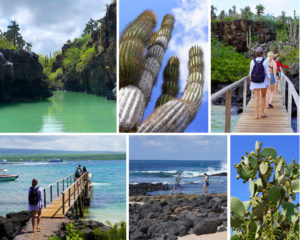
The highlight of the day was undoubtedly swimming in the Cracks (Las Grietas), an inland stretch of emerald-green water nestled at the base of a fissure in the earth. The Cracks are formed by dramatic lava formations, with two towering walls enclosing an arm of brackish water that merges with the sea. While most of the visitors stayed near the entrance of the swimming hole, a few of us decided to venture further past the slippery rock formations to discover the peaceful and isolated area, where we felt completely lost in nature. Reluctantly, I was the last to leave this hidden paradise, and only after the tour guide had to call out my name several times.

Our final stop was “La Lobería” Island (San Cristobal), a sea lion colony where we snorkeled amongst colorful fish, eagerly searching for the playful sea lions.

Puerto Ayora by Night
As the evening set in, we leisurely wandered through the vibrant streets of Puerto Ayora, basking in the delightful ambience. The culinary delights of 1835 Coffee Lab beckoned us and we surrendered to the alluring aroma of affogato and acai bowls.
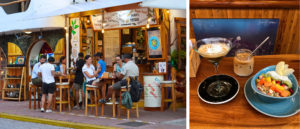
With satisfied cravings, we continued our wanderlust, hunting for keepsakes and gifts to commemorate our Galapagos escapade. Amidst the eclectic mix of stores, the Angelique Art Gallery stood out, its cerulean mosaic-laden walls imparting a distinct allure.
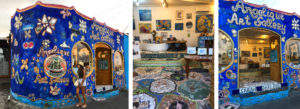
Later, we rendezvoused with the rest of the group for dinner at Almar Seafood & Grill, an idyllic restaurant situated by the oceanfront, offering panoramic vistas of the bay. The restaurant’s commitment to sourcing the freshest local ingredients was evident in their delectable dishes. Ceviche, grilled fish, and seafood paella were among the most popular dishes relished by our group.

We concluded the evening by indulging in a refreshing swim in the hotel pool under the starry sky amidst the serene wilderness that surrounded us. As we lounged in the water, we exchanged tales and anecdotes, cherishing the unforgettable moments we had experienced during our trip.
Isabela Island
We could not leave the Galapagos Islands before going on a full-day excursion to Isabela Island. The journey from Santa Cruz was far from uneventful, as we encountered turbulence on the boat due to towering waves, leading to some passengers experiencing seasickness. Upon arriving at our destination, we immediately set out for the southern coast, home to a group of islets known as “Las Tintoreras,” aptly named after the white-tip reef sharks, or “tintoreras,” that are abundant in the area. Comprised of volcanic rocks, this region is characterized by crystal-clear waters, rugged shorelines, and breathtaking lava formations. We were fortunate enough to witness baby sea lions frolicking in the protected gulf, adding to the magical aura of our adventure.
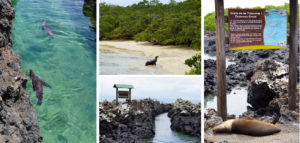
Following a brief lunch break at the port, we journeyed to the picturesque pink flamingo lagoon, where we were treated to the sight of a lone flamingo. We surprisingly learned that their distinct pink hue was the result of a shrimp-rich diet. Next, we visited the Giant Tortoise Breeding Center, where we learned about their breeding and reproductive programs that are carefully implemented to ensure a sustainable repopulation of the island.
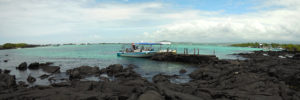
The day culminated in a mesmerizing snorkeling session off the shores of Isabela Island, where we swam alongside awe-inspiring marine iguanas, graceful sea turtles, and an array of colorful tropical fish.
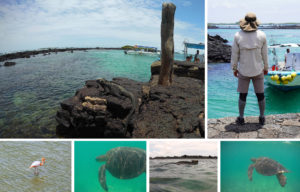
The way back to Santa Cruz was as tumultuous as the boat ride to Isabela Island. Although I found it quite meditative, almost the entire group had to take sea sickness medication to endure it. However, that didn’t deter us from getting back to Puerto Ayora full of excitement to get the most out of our last night there. We spent the evening commemorating a birthday at El Muelle de Darwin, Bar & Restaurant. Later, we sauntered over to a nearby watering hole for craft cocktails and a game of pool.
In retrospect, this voyage was nothing short of a remarkable odyssey. A combination of stunning sceneries, enthralling wildlife, and fascinating history made it a captivating journey full of excitement, leisure, and adventure. From swimming alongside the graceful sea lions, snorkeling with marine iguanas, to witnessing the giant tortoise breeding centers, and the alluring volcanic formations, the trip was an absolute delight. The Galapagos archipelago, an awe-inspiring natural marvel, offers a truly unique experience that should be on every adventurer’s bucket list. However, what made this expedition even more exceptional was the company of our friends. We shared unforgettable moments that we still recall, and even laugh at, to this day. The trip was a remarkable experience that we will always cherish, and we recommend it to anyone seeking an unforgettable escapade.

